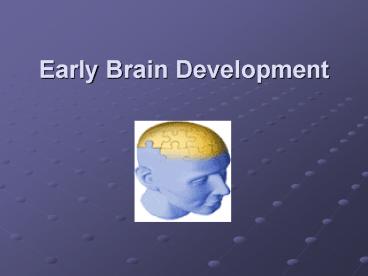Early Brain Development - PowerPoint PPT Presentation
1 / 13
Title:
Early Brain Development
Description:
Early Brain Development Synaptic Activity Rapid climb in first three years Sustained growth until teen years Some decline in teens years Sustained growth over a ... – PowerPoint PPT presentation
Number of Views:958
Avg rating:3.0/5.0
Title: Early Brain Development
1
Early Brain Development
2
Synaptic Activity
- Rapid climb in first three years
- Sustained growth until teen years
- Some decline in teens years
- Sustained growth over a lifetime
3
Neurons The BuildingBlocks
- Born with 100 billion
- Waiting to connect
- Cell body, axon,
- dendrites and synapses
4
Neurotransmitters
- Chemicals that affect the formation, maintenance
and activity of synapses, neurons - Excite or inhibit function
- Over 50 neurotransmitters identified
- Endorphins reduces painSerotonin low levels
are associated with aggression high levels are
associated with lack if initiativeCortisol
activates body/brain defenses when under
stressMelatonin promotes sleepNoradrenaline
along with adrenaline heightens awareness
5
Brain Development
- Cortex - reason and logic
- Limbic - emotion and long-term memory
- Brainstem - survival info. path to spinal cord
and the rest of the body controls involuntary
activities (breathing, heart rate, blood
pressure), - Cerebellum - balance and automatic
movements
6
Regions of the Brain
- CEREBRAL CORTEX
- Frontal lobe - Thought, walking, speech, problem
solving - Prefrontal lobe - Allows for planning and
rehearsing future actions - Parietal lobe - Taste, touch, hand-eye coord.
- Temporal lobe - Memory, emotion, smell, hearing
- Occipital lobe - Vision, visual recognition
- CEREBELLUM - balance, coordination,
cardiovascular activity, breathing - BRAINSTEM - Heart rate, breathing, REM sleep,
crying
7
Review
- What is the brain?How does it function?Why
study the brain?
8
Neuroscience and Research in Early Brain
Development
- Neuroscience deals with the study of nerves and
its structures - With technology, scientists and physicians have
new methods to study the brain that are not
intrusive - MRI (Magnetic Resonance Imaging) gives a detailed
view of the brain - Detailed images of specific regions of the brain
9
Imaging techniques
- Positron Emission Tomography-PET Scan
10
Implications
- Brain research has challenged traditional
assumptions - Once thought that our genes determined how our
brain developed - Genes are relevant in predisposing us toward
certain traits - Environmental factors and an affect on brain
development - Roles of Nature and Nurture determine
intelligence and emotional resilience
11
Environmental Factors
- Care
- Nutrition
- Surroundings
- Stimulation
- What else?
12
Quality of Care
- Nurturing is key to learning and the regulation
of emotional responses - The way parents and caregivers plan childrens
contact with the environment affects the
formation of neural pathways - Secure attachments during the 1rst year of life
seem to predict social competency as child grows - Therefore, quality of care and secure attachment
build healthy brain development.
13
Nurturing Positive Brain Development Means
- Providing a warm and loving environment
- Feeling of safety and security
- Playing interactive games, so children may make
connections to language and sound - Responding to cues and clues in childrens mood
and rhythms - Looking for the teachable moments.































